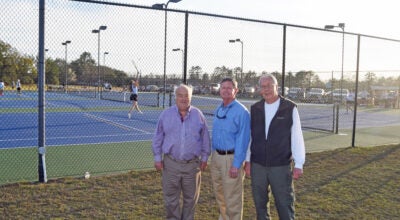National Guard plays role in oil spill response
Published 4:00 am Saturday, July 17, 2010
By DAVID RAINER
Alabama Department of Conservation and Natural Resources
With blades chopping noisily through the thick summer air, the aircraft slowly eased off the ground as Capt. Hugh Bailey and Chief Warrant Officer Lyle Harmon completed the checklist for another mission in the Alabama National Guard’s role in the Deepwater Horizon oil spill response.
Satisfied with the airworthiness, the pilots tilted the UH-72 helicopter forward and picked up air speed and altitude, headed for the flight plan’s route down the Escatawpa River in Mobile County to the Gulf of Mexico.
Starting at Mississippi’s Horn Island, the helicopter crew scanned the nearshore waters of the Gulf for any sign of oil. Crew chief Sgt. Billy Haddan observed out the starboard side and Petty Officer Matt Squires of the Coast Guard handling the port side. Sgt. Maj. Mike Oakley of the Alabama National Guard joined me in the back to shoot photos.
Easing down the barrier islands at a leisurely pace of about 65 knots, the trained observers stared down to catch any glimpse of oil contamination as Bailey and Harmon scanned the surface for oil and the skies for anything that would interfere with the flight, including other aircraft and the numerous coastal birds that sometimes seem to be playing chicken with the aircraft.
“If you look to the left, there is a very light sheen on the water,” Bailey’s voice crackled through the headsets. “That’s the thing about our vantage point. We can see a lot better. If a vessel was going through it, they wouldn’t even be able to tell there was a light sheen.”
For Bailey and Harmon, it’s obvious they enjoy every minute behind the controls of the aircraft. It’s also obvious the mission is foremost.
“The UH-72 Lakota’s mission, as given by the Coast Guard, is nearshore skimmer support and nearshore observation work,” said Bailey, who was deployed to Iraq for a year as a Blackhawk pilot. “This is what the Lakota was built for, a stateside mission to support the state in any aspect it needs in an emergency or in homeland security-type missions. We’re given a set of grids by the Coast Guard each morning and we go out and observe. Because of our agility and field of view, we’re able to go out and find oil quickly. We’re able to mark GPS grids.
“Because of the radios we’re equipped with, we’re able to talk with marine band and Coast Guard band frequencies. We’re able to block areas off (on the grid) and then pass that information to the lead vessels, which then pass the information to the skimmers. We’ll give the lead vessels priorities of heavy or light oil and imminent beach impact. We categorize it as best we can, but we do not tell the skimmers where to go. We give them our observations and let them make the decisions. They run their boats.”
For the past five weeks, Bailey has been on the same mission and he’s seen a variety of conditions.
“Working from Horn Island (Mississippi) to the Alabama-Florida line, there’s been every range of impact from light tar balls to light sheen, like we saw today, all the way up to 6 to 10 square miles of nothing but heavy crude product,” he said. “We have photographs of the vessels skimming the heavy stuff. That’s where the larger vessels come in. The smaller vessels stay nearer the shore and try to protect the beaches with the shallow-draft vessels.”
Easing down the Alabama Coast, we circle the massive operation underway at Katrina Cut, the breach in Dauphin Island caused by the 2005 hurricane, to build a rip-rap wall and make the island one again. Massive piles of sand line the beach on the remainder of Dauphin Island to protect from the oil’s encroachment.
And orange boom is stretched around every cove and inlet or other possible impact area in site. In fact, Alabama has more than 116 miles of hard boom and more than 40 miles of absorbent boom in place.
As we travel down the Fort Morgan peninsula, there’s no oil in sight, although there are plenty of assets in manpower and heavy equipment ready to move on any petroleum that makes its way to the shore.
When we arrive at Orange Beach, a swarm of activity is obvious around Perdido Pass, where the greatest concentration of boom material is seen, both at the pass and inside the mouth of Perdido Bay. Several loops around the Perdido Bay reveal no oil, while only a hint is apparent outside the pass.
Although I admit to being somewhat skeptical before my week at the JIC, actually seeing the work and assets from the air gives me a significantly different perspective. I can’t speak for what’s going on in any of the other Gulf states, but my assessment of what’s happening along the Alabama coast totally aligns with Capt. Bailey’s.
We can only hope and pray they finally get the well capped and sealed soon.
“Inside of Perdido Bay we spoke with a Coast Guard lead vessel and passed on what little we saw outside of Perdido Pass,” Bailey said. “We passed on where we saw the light sheen. Because there’s little to nothing that can be done about it, we just pass that information to the lead vessel. We do get observations from BP aircraft and the Coast Guard. As of (Sunday), the heavy product was about 70 miles away. With tidal movements, currents and storms, it might not ever reach us. It could go east or west or get pulled back out.”
The only way to stay abreast of where the oil is going is to have observers in the air, on the water and along the beaches.
After a week of duty at the response’s Joint Information Center (JIC), I can attest to the Alabama assets that have been put to work to minimize the impact of the oil spill. Other than the National Guard, the list includes the Alabama Emergency Management Agency, the Alabama Department of Environmental Management, the Alabama Department of Public Health, the Alabama Department of Public Safety, the Governor’s Office of Faith-Based and Community Initiatives, the Alabama Forestry Commission, as well as the Alabama Department of Conservation and Natural Resources.
Now consider all the other assets involved – the Coast Guard, U.S. Navy, BP and its contractors.
“This is a massive undertaking,” Bailey said. “I won’t attempt to speak for the Coast Guard, but from my single point of view, the effort has been tremendous. It’s hard to realize how fast this thing grew. But as you saw today, you wouldn’t have expected that three weeks ago we had heavy product on the beach.
“They’ve got people and supplies on the beach every morning. They’ve got vessels of opportunity searching and skimming every single day. The effort has been really well concentrated, and the outcome has been great, so far.”





